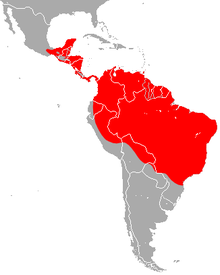Little dog-headed bat
| Little dog-headed bat | ||||||||||||
|---|---|---|---|---|---|---|---|---|---|---|---|---|
| Systematics | ||||||||||||
|
||||||||||||
| Scientific name | ||||||||||||
| Peropteryx macrotis | ||||||||||||
| ( Wagner , 1843) |
The small dog-headed bat ( Peropteryx macrotis ) is a species of bat from the family of the smooth-nosed cantilever (Emballonuridae), which is native to Central and South America.
description
With a total length of less than 62 mm, a forearm length of 38.3–48.2 mm and a weight of 3–9 g, the small dog-headed bat is the smallest representative of the dog-headed bats. In contrast to P. leucoptera , Peropteryx macrotis has no white wings and the ears are not connected to one another by a membrane on the head. The coat color varies geographically from gray to brown to reddish, whereby the belly can appear lighter. The face and muzzle are brown and hairless. The tail is a good third as long as the body and protrudes slightly from the tail membrane at the end . The skin itself is black and ends at the ankles. As with the other representatives of this genus, the wing pouches of Peropteryx macrotis are located on the edge of the flight membrane and open forward.
Way of life
The little dog-headed bat , like most bats, is nocturnal and feeds on insects, with small beetles and flies being preferred prey. The echolocation calls are short (5–9 ms) and of constant frequency in the region of 40 kHz. The calls are therefore inaudible to the human ear.
The species is typically found in moist forests, but has also been caught in dry regions with scrubland. The animals spend the day in caves, doles, ruins, and hollow trees, as well as on bridges, buildings and buttress roots. The species mostly does not depend on horizontal, but vertical surfaces and the animals keep a certain distance from one another. The colonies usually consist of fewer than 15 individuals, with only a single male and a few females present, which could correspond to the social organization of a harem structure. The hanging places divided the little dog's head bat occasionally with other bat species such as P. kappleri , the Great sac-winged bat ( Saccopteryx bilineata ) Glossophaga soricina , G. longirostris , the Seba's short-tailed bat ( Carollia perspiciallata ) Diphylla eucaudata , the black mouse ear ( Myotis nigricans ), M keaysi and the common vampire ( Desmodus rotundus ). Peropteryx macrotis can reproduce all year round in both the dry season (January – July) and the rainy season (July – December). The species is therefore likely to be seasonally polyestrial . The wearing time lasts 4–4.5 months. Males likely use a scent during courtship that they mix in their flight membrane pockets, similar to other smooth-nosed cantons such as the sack - winged bat. In females, the flight skin pocket is only rudimentary . Well-known predators of Peropteryx macrotis include owls and the partially carnivorous bat species Chrotopterus auritus .
distribution and habitat
The small dog-headed bat occurs from southern Mexico to Paraguay . The species is classified as harmless by the IUCN .
literature
- DA Yee (2000): Peropteryx macrotis . In: Mammalian Species , No. 643, pp. 1-4
Individual evidence
- ↑ Rydell, J., Arita, HT, Santos, M., & Granados, J. (2002). Acoustic identification of insectivorous bats (order Chiroptera) of Yucatan, Mexico. Journal of Zoology, 257 (1), 27-36.
- ↑ Peropteryx macrotis in the IUCN Red List of Threatened Species .
